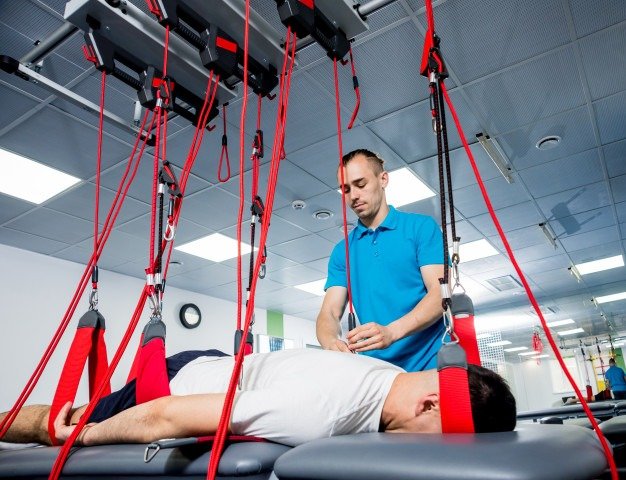
Traction Therapy
What is traction therapy
The foundation of the treatment option known as traction is the application of a longitudinal force on the spinal column’s axis. In order to stabilize or adjust the position of injured sections of the spine, the spinal column’s components are tucked in opposite directions. The patient must either be maintained in bed or placed in a halo vest as the force is often supplied to the head using a series of weights or a fixation device. A physical procedure called traction is intended to relieve pressure on painfully impacted spinal discs. By manually “extending” the spine, traction relieves strain on the discs and lessens a person’s pain.
With the aid of a head or chin sling, mechanical, motorized, or supine posterior distraction unit, cervical traction is frequently carried out. In the supine posture, mechanical cervical traction can be used to lower head weight but increase frictional resistance. In addition to being more comfortable, this position enables the patient to manage their head more effectively.
In comparison to cervical traction, lumbar traction requires a much higher force to divert the vertebral segments. A thoracic or chest belt with a pelvic belt, inversion, a split traction table, or an auto traction table are examples of common traction systems. A movable half and a fixed half are both included in split traction tables. Auto traction tables let the patient control the movement of both table parts. Assuming the least painful position, the patient applies active traction by tugging on an overhead bar. The patient then activates a bar with his or her feet, which alternately applies compressive and distracting stresses.
WHAT DIFFERENT KINDS OF TRACTION THERAPY ARE THERE?
Depending on your needs, manual or mechanical spinal traction therapy can be used.
Manual Traction : In manual spinal traction, a physical therapist pulls patients into a traction position with their hands. Then, they enlarge the gaps between the vertebrae by applying physical pressure to the joints and muscles. Typically, the traction phase doesn’t last very long. Although manual traction sounds very terrifying, it is a safe therapy option that may work for some illnesses.
Mechanical Traction : Devices that work by stretching the muscles and spinal vertebrae are used in the specific therapy method known as mechanical traction. On a traction table, mechanical traction combines heat, vibration, and/or massage while allowing for continuous or sporadic stretching. These tables can apply precise pressures and/or pressure variations using computer-based methods. However, individuals with major bone diseases such osteoporosis, osteomyelitis, and bone malignancy, as well as those with heart disease and spinal cord disorders, should not undergo mechanical traction. Additionally, anyone with arthritis or spinal fractures should avoid it. To ensure effectiveness and safety, this sort of treatment should only be considered after rigorous evaluation and diagnosis, under the professional supervision of a registered physical therapist or physician.
How Does it Work ?
Each disc in the spine is a circular structure that lies between the vertebrae. Its delicate inner tissue is surrounded by a hard outer layer. A disc that has been damaged by pressure has a gap where the soft inside protrudes through the resistant outer covering. This protrusion hurts because it pulls on adjacent nerves. Pressure on the disc is relieved by traction pulling the vertebra away from it. This makes it easier for the disc’s soft interior to re-enter the disc. The nerve is released, which lessens discomfort.The disc is rehydrated as a result of this. Pain is reduced and pressure on the spine is released thanks to traction. While cervical traction and lumbar traction are similar, they differ significantly in a few important ways. With cervical traction, the head is gently pulled or stretched away from the neck. With lumbar traction, the pelvis is gradually separated from the lower back using a light force. Both of these techniques are effective for adjusting the spine and bringing about alleviation.
CONDITIONS TREATED?
Stretching soft tissues and separating joint surfaces or bone fragments with traction is a technique. The force that is applied needs to be strong enough and long enough to move in the right direction, while opposing the body’s motion with a force that is also strong. This therapy benefits those with particular spinal disorders and is most frequently used to treat:
- Slipped discs
- Bone spurs
- Degenerative disc disease
- Herniated discs
- Facet disease
- Sciatica
- Foraminal stenosis
- Pinched nerves
- Cervical Spondylosis
- Lumbar Spondylosis



